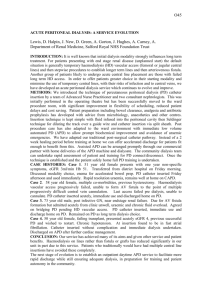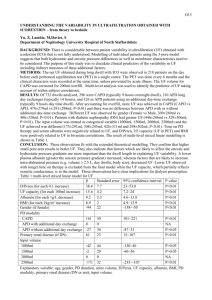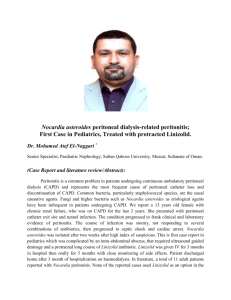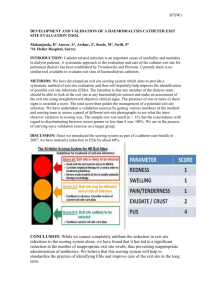Possible Problems with Peritoneal Dialysis
advertisement
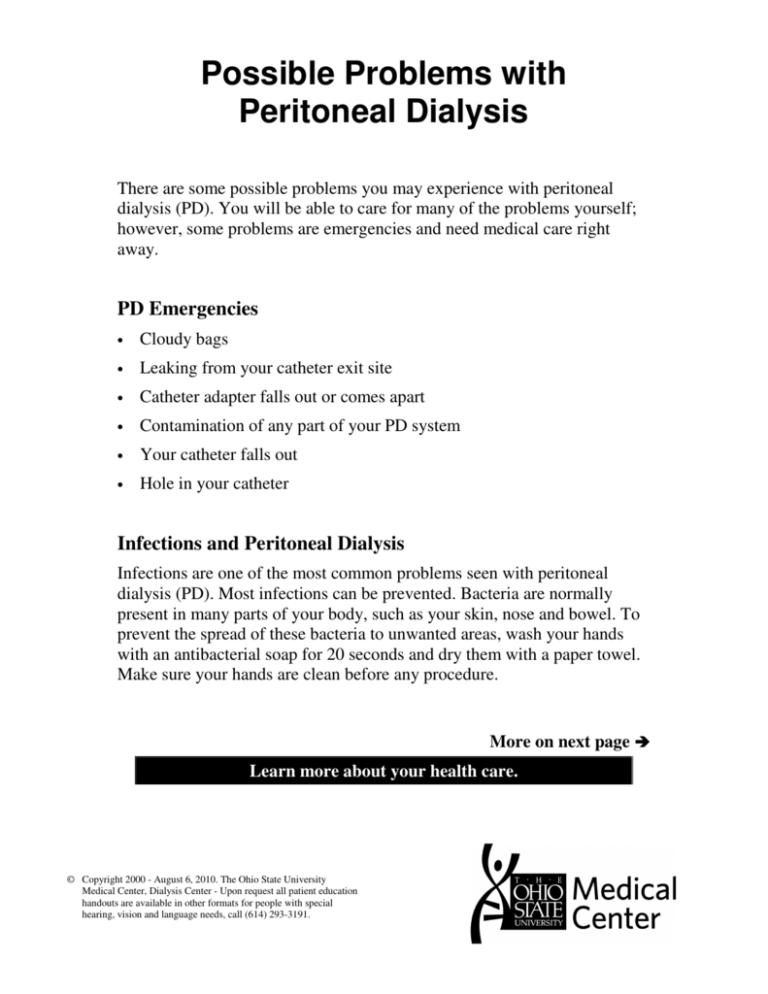
Possible Problems with Peritoneal Dialysis There are some possible problems you may experience with peritoneal dialysis (PD). You will be able to care for many of the problems yourself; however, some problems are emergencies and need medical care right away. PD Emergencies • Cloudy bags • Leaking from your catheter exit site • Catheter adapter falls out or comes apart • Contamination of any part of your PD system • Your catheter falls out • Hole in your catheter Infections and Peritoneal Dialysis Infections are one of the most common problems seen with peritoneal dialysis (PD). Most infections can be prevented. Bacteria are normally present in many parts of your body, such as your skin, nose and bowel. To prevent the spread of these bacteria to unwanted areas, wash your hands with an antibacterial soap for 20 seconds and dry them with a paper towel. Make sure your hands are clean before any procedure. More on next page Learn more about your health care. © Copyright 2000 - August 6, 2010. The Ohio State University Medical Center, Dialysis Center - Upon request all patient education handouts are available in other formats for people with special hearing, vision and language needs, call (614) 293-3191. Page 2 Condition Signs Peritonitis Peritonitis is an inflammation of the peritoneum, the membrane lining the abdominal wall, through which your catheter has been placed and where the PD occurs. Signs of peritonitis may include: cloudy PD drainage, abdominal pain or tenderness, poor outflow, nausea or vomiting, and fever. • Exit Site Infection An infection at the site of your PD catheter exiting from your skin can occur. • • • You are at risk for peritonitis when your hands are not clean or the correct procedure for following PD is not used. You are also at risk for peritonitis if you have any of these factors: Touch contamination Improper taping of site catheter or not protecting from friction Exit site infection Bowel perforation Carrier of Staph infection Recent dental visit without antibiotic coverage Diabetes Mellitus Invasive procedure such as colonoscopy or abdominal surgery within 24 hours Diverticulitis Constipation / Diarrhea Poor hygiene Supplies not kept sterile, or a hole in tubing or bag Treatment If you see a cloudy bag, call your doctor or CAPD unit right away. Save the cloudy bag. Redness, pain and drainage at If you have drainage from the exit site are signs of the exit site, call your CAPD infection. unit right away. Causes of infection can be • To promote healthy exit from: sites: Not cleaning your site daily Avoid submerging exit site in bath water Not protecting your site from irritation Avoid "bending type" exercises Improperly taping your catheter to your abdomen Follow proper procedure for PD exchanges Wear loose clothing that will not rub the site Page 3 How to Prevent PD Infections • Use sterile technique. Wash your hands with soap and water before starting any procedure. Place a mask on everyone in the room while you are performing PD exchanges. Clean your table or countertop with antibacterial cleaner before you begin. • Do all procedures the way you were taught by your CAPD unit. • Make sterile, tight connections during bag exchanges and avoid contamination when injecting medicines. If any piece of equipment or materials may have been contaminated before use, throw it away it and get new items. • Pay attention to what you are doing, and do not allow distractions, such as from children or pets. • Do exit site care every day and protect it with a dressing. Tape the tubing to the skin to prevent pulling on the site. Avoid tight fitting clothing that can rub the site. • Call your CAPD unit before any dental or diagnostic procedures. Other PD Problems and Treatments Following is a list of possible problems that may occur. Included is a definition of the problem, actions to take to prevent it, what to watch for, and what to do. If you are not certain of what to do, call your CAPD unit. Condition Spike Contamination A spike contamination happens when the end of the spike touches something that is not clean (sterile). Signs Treatment • If you think that the spike has been contaminated: Stop the PD exchange! Do not allow PD fluid to flow in. Call your CAPD unit or doctor. Do not do another exchange until you have talked to your CAPD nurse or your doctor. Page 4 Condition Signs Fluid Overload Fluid overload is the inability to remove excess body fluid due to the loss of kidney function. It is important to know your dry weight and to monitor your weight and blood pressure every day. Dehydration Dehydration is the removal of too much body fluid due to diet, dialysis or illness. It is important for you to know your dry weight, and monitor your weight and blood pressure. Exit Site Leaking Leaking can occur where the dialysis fluid leaks out around the exit site of the catheter. • Hernia or Subcutaneous Leak A small or large area of tissue becomes large and hard under the skin, close to the exit site of your catheter. • • • • • • • • Shortness of breath Swelling in arms and legs, face or abdomen Cough, especially when lying flat at night Increase in weight and / or increase in blood pressure Treatment Call your Doctor or CAPD nurse right away if you have signs of “fluid overload.” • Follow your diet restrictions. Dizziness and / or ringing in Call your Doctor or CAPD ears unit right away if you have Decrease weight and blood symptoms of “dehydration.” pressure Cramping in fingers, feet, toes, stomach Increase fluid and salt in diet • • • • • Localized swelling on stomach or groin area Decrease in amount of drainage in bag Redness and pain in area of swelling Increase in weight • • Call your Doctor or CA PD unit right away if you have leaking from your exit site. To help prevent exit site leaks: Avoid heavy lifting, contact sports or strenuous activity Wear clothing that does not rub the site Make sure there is proper taping of the catheter and exit site. Call your Doctor or CA PD unit right away if you have leaking from your exit site. Follow the guidelines for preventing exit site leaks to help prevent hernia or subcutaneous leaks. Page 5 Condition Signs Cuff Erosion Cuff erosion is when the cuff of the catheter is seen at the skin exit site. • Blood in Effluent If dialysis effluent (drained dialysis solution) appears pink or red, you may have blood in effluent. • • • Treatment Possible pain and purulent drainage at the exit site Cuff seen at the exit site • Call your Doctor or CAPD unit right away if you can see your cuff. Pink-tinged drained dialysis solution For women: menstruation may cause bleeding in drained dialysis solution • Call your Doctor or CAPD unit right away if you see blood in your effluent. To prevent blood in effluent: Always tape the tubing to your skin, to avoid pulling on the catheter. Avoid heavy lifting, strenuous exercise or contact sports. • Pain If you have pain with peritoneal dialysis, talk with your doctor or CAPD unit for treatment. Type of Pain Treatment Inflow Pain Inflow pain can occur depending on the position of the catheter. • Tell your Doctor or CAPD unit if you have pain with your exchanges. Decrease inflow of dialysis solution using roller clamp Change position: stand, sit, or lie down Empty Pain Empty pain is a sharp pain at the end of drain. • Tell your Doctor or CAPD unit if you have pain with your exchanges. Back Pain Solution in the abdomen can cause pressure on the lower back. • Tell your Doctor or CAPD unit if you have back pain. Remove all air from tubing before inflow of solution Have good body posture to reduce this pressure. Shoulder pain May occur after your catheter is placed. • Tell your Doctor or CAPD unit if pain does not improve. Page 6 Problems with Solution Flow If you have trouble with solution flow during PD exchanges call your doctor or CAPD unit. Solution Problem Treatment Poor solution flow into peritoneal cavity • Call your Doctor or CAPD unit if you are unable to perform your exchange. Make sure correct clamps are open Check for kinks along tubing & catheter Change position: sit, stand or lie down Cough Repeat exchange with new supplies Fibrin White strands of protein or “egg white” seen in the drained dialysis solution can cause slow drainage or inflow • Tell your Doctor or CAPD unit if you see fibrin in your effluent (drained dialysis solution bag). Poor Solution Flow out of Peritoneal Cavity • Call your Doctor or CAPD unit if you are unable to perform your exchange. Make sure correct clamps are open. Check for kinks along tubing and catheter Check for kinked tubing Change position Constipation Constipation is the most common cause of poor outflow in peritoneal dialysis. • Call your Doctor or CAPD unit if you are unable to perform your exchange. Page 7 Other Problems Here are common problems that some people have with PD. Call your doctor or CAPD unit with questions or concerns. Solution Problem Treatment Hole in transfer set • If you have a hole in your transfer set or catheter, stop dialysis right away. Call your doctor or CAPD unit. Do not use pins or scissors anywhere near your CAPD catheter. Clamp the transfer set or catheter ABOVE the hole. Anemia Low red blood cell counts. • Call your Doctor or CAPD unit if you have any signs of anemia: Low energy, feel tired or weak Possible shortness or breath Chest pain High phosphorous This is the inability to remove phosphorus due to the loss of kidney function. • Call your Doctor or CAPD unit if you have any signs of high phosphorus: Extreme itching Bone pain Itching Also called Pruritus • Call your Doctor or CAPD unit if you have severe itching: High levels of phosphorous can cause itching Take calcium (phosphate binder) as prescribed Lotions may be given to reduce itching Low on Dialysis Supplies • Call your CAPD Unit if you are running low on supplies. Talk to your doctor or others on your health care team if you have questions. You may request more written information from the Library for Health Information at (614) 293-3707 or email: healthinfo@osu.edu.
